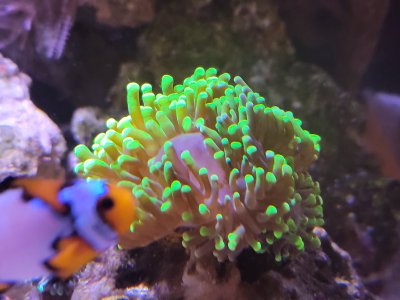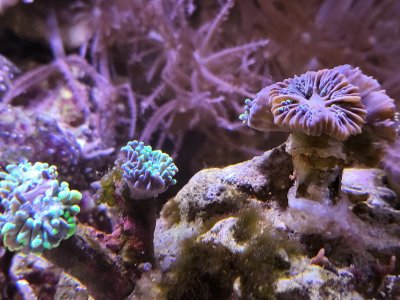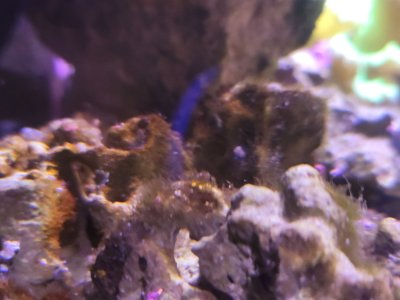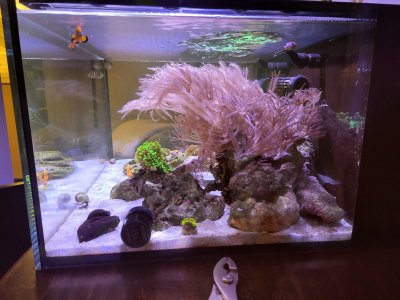You are using an out of date browser. It may not display this or other websites correctly.
You should upgrade or use an alternative browser.
You should upgrade or use an alternative browser.
WTF is wrong with my hammers?
- Thread starter mumra
- Start date
current levels (and generally steady at these numbers)
Alk: 7.5 (usnally a bit over 8)
Mag: 1125
Cal: 400
Alk: 7.5 (usnally a bit over 8)
Mag: 1125
Cal: 400
Mag is definitely low, though mag tests have a margin of error around 2-300 PPM so you have to take them with a grain of salt. Other params seem fine.
An infection is definitely at hand. Do a dip as soon as possible, and keep an eye on them for brown jelly. My favorite dip recipe is derived from the KFC dip:
Iodine
Amino acids
Ciprofloxacin (chemiclean works too)
To about half a gallon of water, add enough iodine until the water is light tea colored. To this add 250MG of Cipro (or two scoops of chemiclean) and a couple of tablespoons of aminos. The aminos coerce the coral to absorb the antibiotics for more effective application. Dip the hammers for 15-30 minutes, removing at any signs of degradation. Repeat once every three or four days until you begin seeing tissue regrowth, then do one final dip.
Hope they pull through! This mix has not failed me yet (knock on wood).
An infection is definitely at hand. Do a dip as soon as possible, and keep an eye on them for brown jelly. My favorite dip recipe is derived from the KFC dip:
Iodine
Amino acids
Ciprofloxacin (chemiclean works too)
To about half a gallon of water, add enough iodine until the water is light tea colored. To this add 250MG of Cipro (or two scoops of chemiclean) and a couple of tablespoons of aminos. The aminos coerce the coral to absorb the antibiotics for more effective application. Dip the hammers for 15-30 minutes, removing at any signs of degradation. Repeat once every three or four days until you begin seeing tissue regrowth, then do one final dip.
Hope they pull through! This mix has not failed me yet (knock on wood).
You will need to further diagnose ..
- Is it only the hammers or are other species also showing a change in behavior ?
- Anything changed in maintenance routine ? Flow/Lighting/Water changes ?
- ph/temp/salinity stability ? Calc/Alk/Mag is lower than what a tank would be at with regular water changes.
- skimmer ?
- night time visitors ?
- day/night cycle - variances/behavior ?
if nothing shows up, then default is water changes / carbon (if there are pollutants/coral warefare buildup).
- Is it only the hammers or are other species also showing a change in behavior ?
- Anything changed in maintenance routine ? Flow/Lighting/Water changes ?
- ph/temp/salinity stability ? Calc/Alk/Mag is lower than what a tank would be at with regular water changes.
- skimmer ?
- night time visitors ?
- day/night cycle - variances/behavior ?
if nothing shows up, then default is water changes / carbon (if there are pollutants/coral warefare buildup).
I assume that I can get this ciprofloxacin at the LFS. I'm stopping by one today. can/should I dip the whole rock they are on? I suck something fierce at gluing , so I want to avoid trying to move things.Mag is definitely low, though mag tests have a margin of error around 2-300 PPM so you have to take them with a grain of salt. Other params seem fine.
An infection is definitely at hand. Do a dip as soon as possible, and keep an eye on them for brown jelly. My favorite dip recipe is derived from the KFC dip:
Iodine
Amino acids
Ciprofloxacin (chemiclean works too)
To about half a gallon of water, add enough iodine until the water is light tea colored. To this add 250MG of Cipro (or two scoops of chemiclean) and a couple of tablespoons of aminos. The aminos coerce the coral to absorb the antibiotics for more effective application. Dip the hammers for 15-30 minutes, removing at any signs of degradation. Repeat once every three or four days until you begin seeing tissue regrowth, then do one final dip.
Hope they pull through! This mix has not failed me yet (knock on wood).
Cipro is usually only by prescription... I have my dad (who is a vet) write a scrip for me and I keep a little stash. Chemiclean is Erythromycin (I believe) and will work just as well. You can get this at the LFS.I assume that I can get this ciprofloxacin at the LFS. I'm stopping by one today. can/should I dip the whole rock they are on? I suck something fierce at gluing , so I want to avoid trying to move things.
You could theoretically dip the whole rock, but you would likely need a larger container and thus more solution would be needed. I can't think of any ill effects from doing this though.
- only the hammers. I have a zoa that hasn't done ish since I got it but other than that everything else is great. in fact I have an anthelia that I thought was at fault for this by blocking the light because it had gotten so big. I moved it back and some other things to clear the light.You will need to further diagnose ..
- Is it only the hammers or are other species also showing a change in behavior ?
- Anything changed in maintenance routine ? Flow/Lighting/Water changes ?
- ph/temp/salinity stability ? Calc/Alk/Mag is lower than what a tank would be at with regular water changes.
- skimmer ?
- night time visitors ?
- day/night cycle - variances/behavior ?
if nothing shows up, then default is water changes / carbon (if there are pollutants/coral warefare buildup).
- no changes. light and flow have not changed in over 6 months, probably closer to a year. I just did a 5gal water change last week with water from the same LFS I've always gotten it from and the tank it comes from looks great.
-temp got a little low for a few hours after my water change because I forgot to turn it back on. but it holds steady at 77-78F. my battery died in my refract so I couldn't test the salt today but of all my parameters that one has been dead on since day one. it's hardly ever moved at all.
-visitors?
-no cycle changes or variances.
I'll post up a could of full tank pick in a second.
btw: I have this little brown stuff popping up again. I assumed it was dino and treated it with microbacter7 and a uv filter. that killed it pretty good but it came back after I forgot to turn it back on over a weekend. but it's not nearly as bad as before.
btw: I had a sand sifting starfish go missing about a month ago. I assume it is dead and I cannot find a trace of it after digging around and sifting the water during the last 2 water changes. I figured the crabs ate it. idk
I have a bottle of Coral Rx. not exactly what were looking for here though, right?Cipro is usually only by prescription... I have my dad (who is a vet) write a scrip for me and I keep a little stash. Chemiclean is Erythromycin (I believe) and will work just as well. You can get this at the LFS.
You could theoretically dip the whole rock, but you would likely need a larger container and thus more solution would be needed. I can't think of any ill effects from doing this though.

Coral Rx Coral Dip - 8 oz
Why does BRS recommend this? Coral RX has proven its worth time and time again. With new corals from so many different sources, whenever we dip our corals here at BRS we almost always find some type of pest or critter that we do not want in our tank. Coral Rx was developed to be safe for your...
This is a pest dip, so it wouldn't do much for an infection. At the very least, iodine and aminos should take care of it. Chemiclean/Cipro will make it faster and more effective though.I have a bottle of Coral Rx. not exactly what were looking for here though, right?

Coral Rx Coral Dip - 8 oz
Why does BRS recommend this? Coral RX has proven its worth time and time again. With new corals from so many different sources, whenever we dip our corals here at BRS we almost always find some type of pest or critter that we do not want in our tank. Coral Rx was developed to be safe for your...www.bulkreefsupply.com
A word or caution, make sure to dispose of the wastewater properly if you end up using antibiotics. Let it sit in bright sunlight for a day, add carbon to remove any stragglers, and flush the remainder down the toilet. Most terrestrial bacteria is already pretty resistant to Cipro but better to be safe than sorry...
Everything else in the tank looks wonderful, so infection is definitely at hand in some amount.
I would tend to agree .. the only question in my mind is when to intervene as there is risk in any treatment.Everything else in the tank looks wonderful, so infection is definitely at hand in some amount.
My suspicion would be Brown jelly disease (BJD) .. common in euphelia. The signs although would be the telltale melting/brown jelly, but that is an advanced stage. Have you tried "blowing" the corals with a turkey baster and seeing what detritus comes off ?
like the wastewater would be dangerous to people and pets? I guess pouring it out in the backyard wouldn't be a good idea if that is the case. could I bleach the wastewater?This is a pest dip, so it wouldn't do much for an infection. At the very least, iodine and aminos should take care of it. Chemiclean/Cipro will make it faster and more effective though.
A word or caution, make sure to dispose of the wastewater properly if you end up using antibiotics. Let it sit in bright sunlight for a day, add carbon to remove any stragglers, and flush the remainder down the toilet. Most terrestrial bacteria is already pretty resistant to Cipro but better to be safe than sorry...
that stuff is stuck on there good. I can't hardly get off even with my fingers. occasionally I can get a piece but 99% stays. it's even growing on my snails shells.I would tend to agree .. the only question in my mind is when to intervene as there is risk in any treatment.
My suspicion would be Brown jelly disease (BJD) .. common in euphelia. The signs although would be the telltale melting/brown jelly, but that is an advanced stage. Have you tried "blowing" the corals with a turkey baster and seeing what detritus comes off ?
The brown stuff on the rocks isn't brown jelly. I have never worried about my rocks going brown (or green) with age. I don't think that is related ..that stuff is stuck on there good. I can't hardly get off even with my fingers. occasionally I can get a piece but 99% stays. it's even growing on my snails shells.
I could not spot the brown jelly stuff on your hammers, but something clearly is stressing/pissing them off. But this may simply be too early to tell ..
Here is a good pic for BJD, I think your first pic (where you thought it was splitting) is showing the first stage -
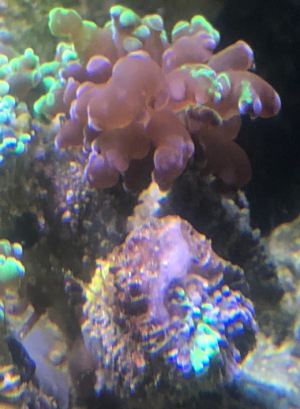
Last edited:
are you sure thats a hammer? the first photo looks like it could be a torch
Seems to be a frammer of some sort... There are some bean-shaped tips hidden in there.are you sure thats a hammer? the first photo looks like it could be a torch
No on both accountsHave you noticed any flatworms on it? Have you tried dipping it?
Similar threads
- Replies
- 1
- Views
- 135

